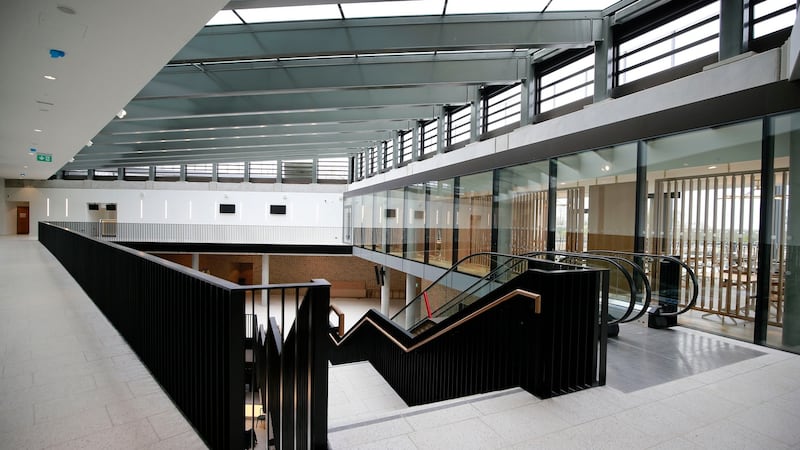After four years and just over €80 million the new Curragh opens to the public today. Irish racing's flagship facility has been built. The question now is will people come? For the sport's biggest ever capital development project to justify itself they have to. And not just out of curiosity's sake.
Nearly nine thousand tonnes of concrete has been poured into the spectacular new grandstand but a lot of sentiment has accompanied it too. That’s an intangible consideration, invisible on any bottom line, yet something by which the new Curragh will ultimately be judged.
During its lengthy construction a restricted programme was held at Irish racing’s HQ on what was basically a building site. Improvisation helped keep the show on the road with temporary facilities catering for restricted audiences. But, crucially, on telly everything looked just the same.
Cameras followed some of the best thoroughbreds and jockeys in the world thundering over the famous Kildare plain and it looked to millions of punters like business as usual.
It didn’t matter that backstage the jockeys’ loo was a Portakabin, or that the Members’ bar flapped in the wind like a point-to-point tent, just as it will be irrelevant to TV viewers this afternoon that every element of the new facility is state of the art.
On screen the core element of horses and jockeys competing against each other is always front and centre, whatever is happening off camera.
That’s what counts to the vast majority of the sport’s audience and it’s what is most lucrative. A media rights deal that makes even the most ordinary race worth about €7,000 to the racecourse hosting it means boots on the ground have become a trifling financial consideration.
If a run of the mill seven-race programme can generate fifty thousand, a Group One card is apparently worth nearly double that to a racecourse executive in terms of pictures. It makes totting up the proceeds from 20 quid a skull through the gates feel like very small beer.
Effectively turning tracks into massive TV outdoor studios has emerged as the most profitable part of any racecourse’s financial tot. That has made investing in facilities for declining numbers prepared to actually go racing outside of the big festival dates a comparative indulgence.
It’s why chronic fears remain that spending €80 million – more than €30 million of it public money – has the potential to turn a transformed Curragh into a perfectly appointed white elephant.
It’s a one-dimensional dread in some ways. The eyes of the racing world are on the Curragh’s major dates. So there is a sales-pitch industry element to keeping the best side out rather than maintaining a dilapidated eyesore as the Curragh infrastructure used to be.
It's why five investors, John Magnier's Coolmore Stud, Sheikh Mohammed's Godolphin operation, the Aga Khan, Moyglare Stud and JP McManus all put in €5 million each when the project was launched back in 2015.
Sheikh Hamdan's Derrinstown Stud joined them later while Juddmonte Farms and David Power, the co-founder of Paddy Power, have also contributed.
Private investors, along with the State through Horse Racing Ireland, and the Irish Horseracing Regulatory Board (IHRB), who provided the facility but no money, have one-third voting shares on the board of Curragh Ltd.
However, while it may be a one-dimensional argument about it all being little more than a chance for a tiny rich elite to show off to their international brethren on home ground, many find it a compelling one just the same.

In the past any such elitism was a mostly private party. The IHRB, under its Turf Club banner, ran a facility that filled only on Irish Derby day. Even other classic days showed echoing evidence of a disconnect with any kind of substantial audience.
“Industry” dates featuring young equine talent which could go on to dominate the world mostly took place before a paying audience that could be counted in handfuls.
The fact it happened in the middle of Kildare, the “Thoroughbred County”, illustrated stark evidence of a disconnect with the audience on its doorstep, never mind 30 miles up the motorway in Dublin.
Changing that won’t be a major financial factor in the new Curragh’s long-term future. But by every other measure attendances are going to be a vital barometer of this huge investment.
What otherwise is the point of spending €80 million on a modern facility capable of catering for 30,000 people if on most days crowds can continue to be counted in hundreds?
The reassuring comfort blanket about no one going to the Curragh because it was a bit of a kip doesn’t apply anymore. It is now an impressive, contemporary arena that can justifiably be shown off.
But for it to be perceived as being more than an elitist whim it must mean more to the rest of us than something to stare at as we whizz past on the M7. In particular it has to mean more to what really ought to be a captive local audience.
Just 10 miles away, the Punchestown Festival wound up on Saturday with more than 37,000 people attending its Family Day fixture. This is a date that has ballooned over the last decade on the back of concentrated promotion at local level.
Financially, such figures are a cherry on top of TV revenue. But live crowds remain a crucial gauge of any sport’s popular appeal and encouraging attendance is a vital investment in future sentiment.
Today, and into the future, the Curragh will look the same on screen as it always has. However, a substantial investment has been made to create something for people to actually pay into and experience.
If they’re not encouraged to do so, or feel they’re being treated as optional extras if they do, good only for applauding the great and the better, then such spending may come to be regarded as little more than hollow self-indulgence.













